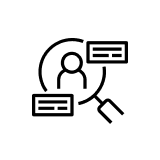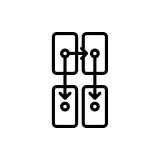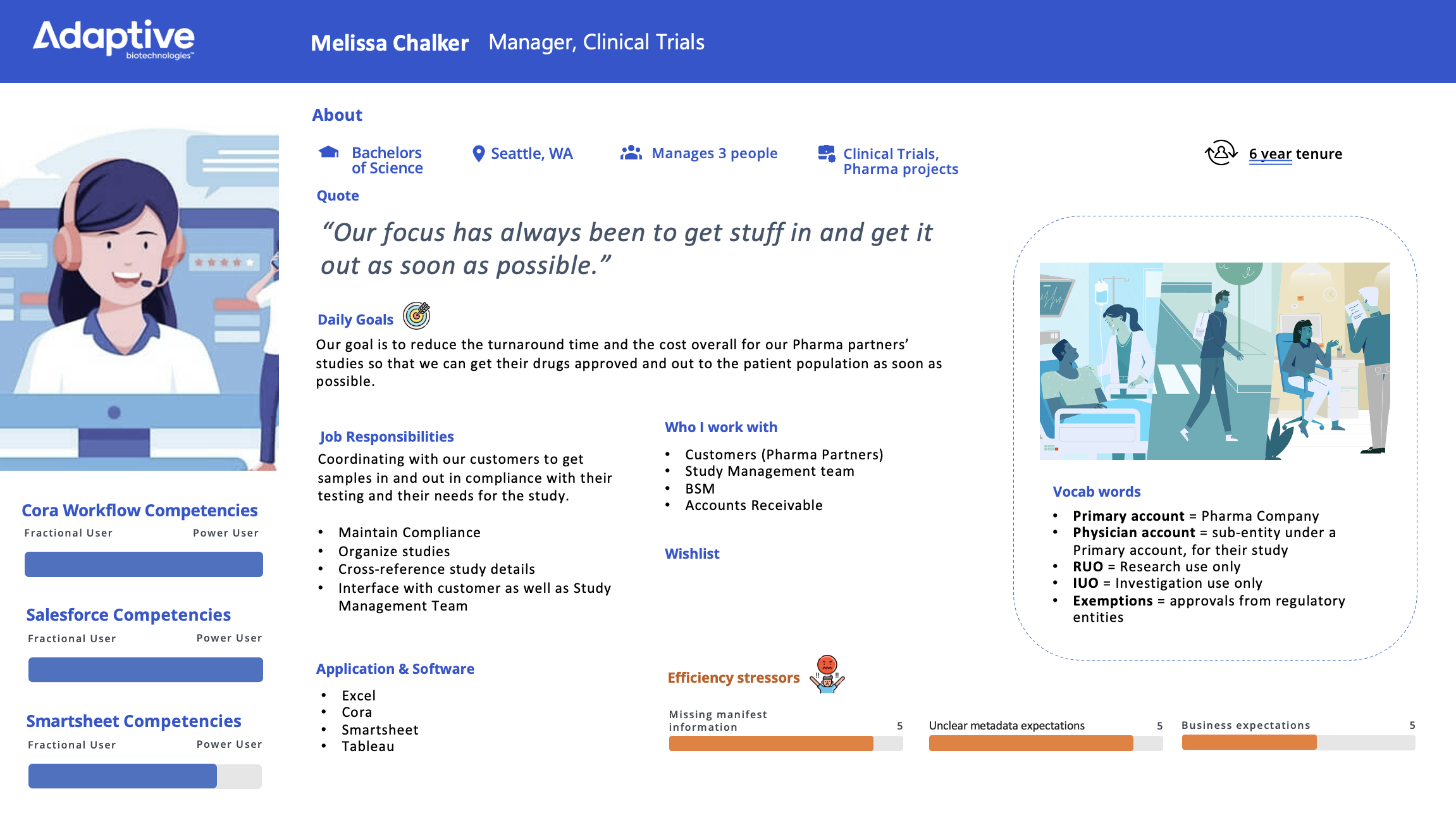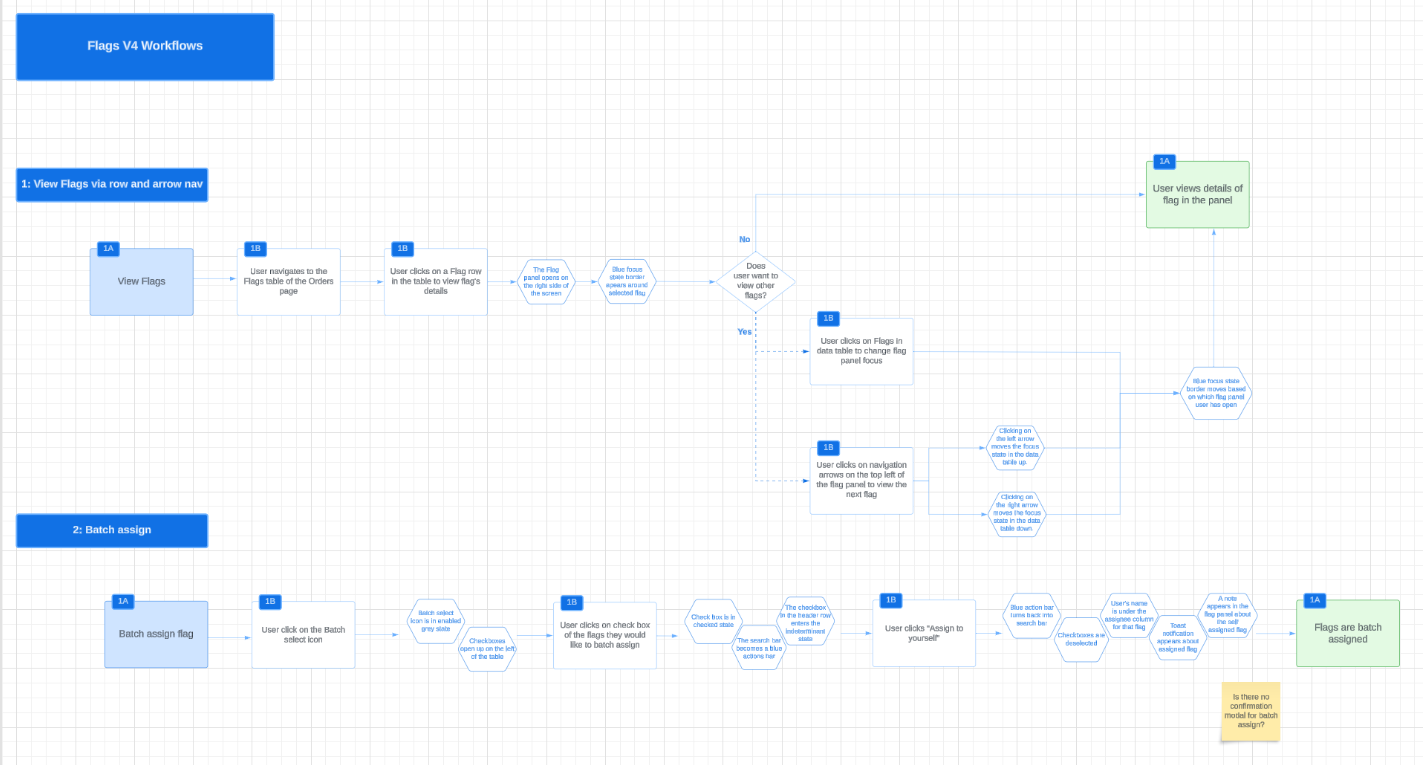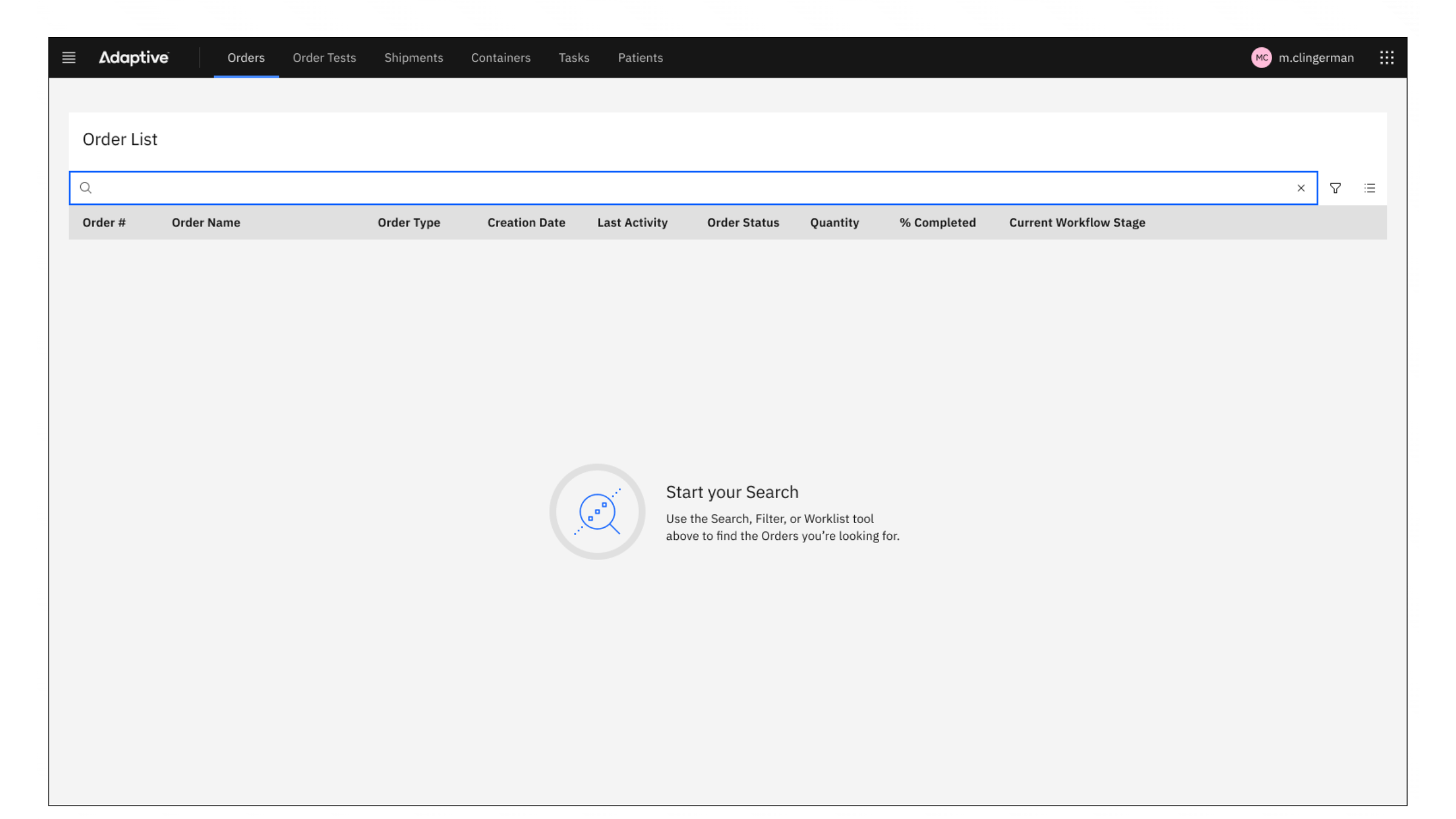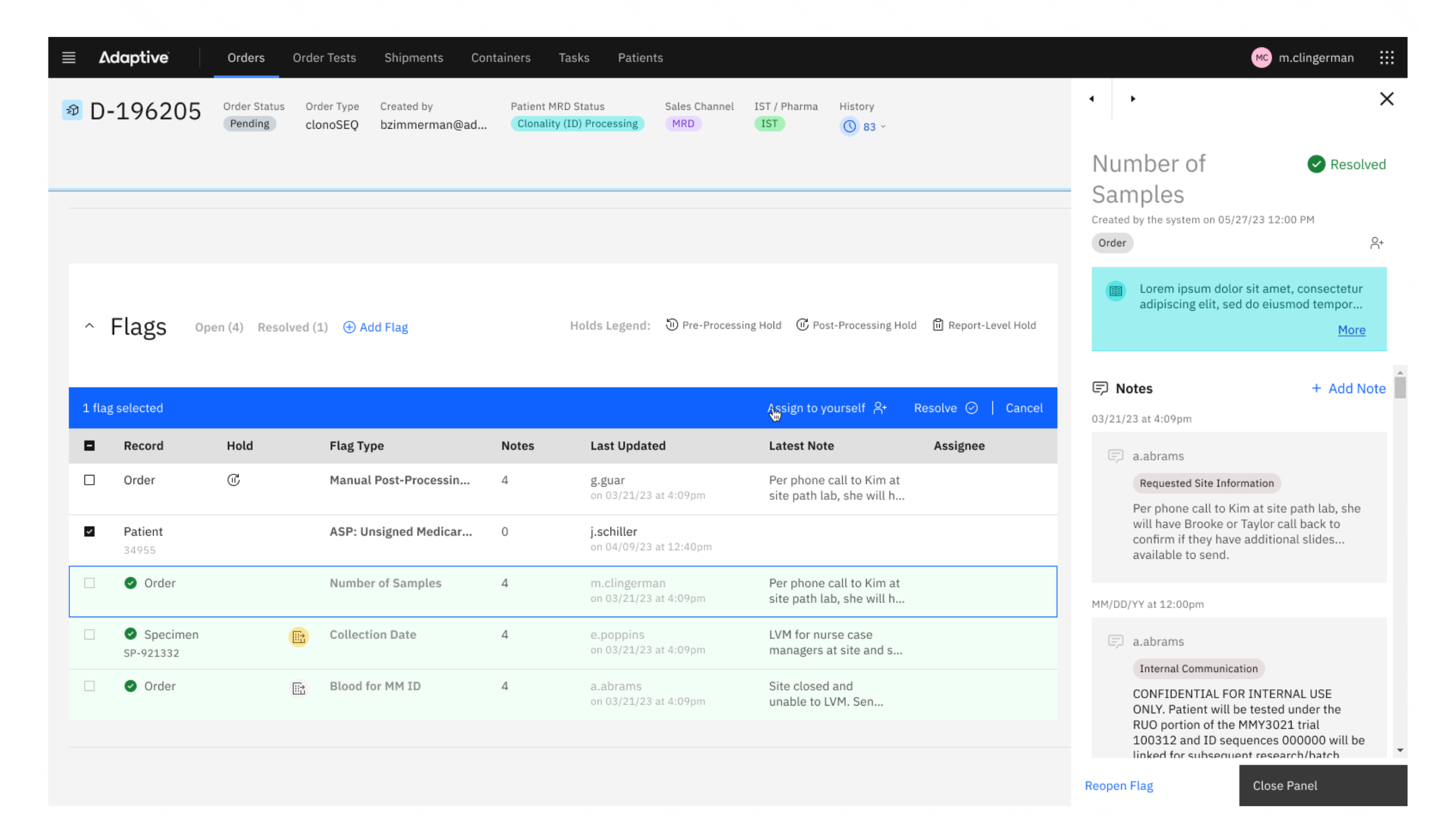Adaptive Biotechnologies
Adaptive Biotechnologies Corp (Adaptive) is a biotechnology company specializing in immune-driven medicine. They utilize their proprietary technology platform to decode the adaptive immune system and develop clinical diagnostics and therapeutics for various diseases, including cancer, autoimmune disorders, and infectious diseases.
Description
Adaptive provides an immune-sequencing platform for oncology, immune diseases, and vaccine development. They develop assays for clinical diagnosis and monitoring using high-throughput sequencing to profile T-cell and B-cell receptors. Adaptive translates immune-sequencing findings into diagnostics and therapies. The Order Management System (OMS) and Laboratory Information Management System (LIMS) streamline orders for both clinical diagnostics and clinical trials, managing incoming requests to process patient specimens through Adaptive’s immune sequencing pipelines. As part of the UX team, I was assigned to innovate and improve the OMS and LIMS ecosystem.
My role
Research
User Flow
Prototyping
Wireframing
Components
User Research
To enhance our understanding of the users, the following methods were implemented:
A small group of subject matter experts (SMEs) was selected to serve as our primary representatives for UX research
Ongoing one-on-one interviews were conducted with SMEs to identify pain points and collaborate on generating ideas
Weekly group meetings with SMEs were utilized, during which we gathered feedback and guided iterations on new designs
Persona example
The Solution
The Problem
Users were overwhelmed with an abundance of fields and an overload of information.
Latency issues were addressed by employing an Empty State pattern, guiding users to search and filter tools for a more targeted dataset. By collaborating with SMEs, key filter fields were chosen for each list. This ensured practicality and relevance in data interaction scenarios.
Expandable Rows in Data Tables
Custom Filter bar
Flags
By incorporating a right-hand Flag Panel, Flag content was contained both visually and functionally. By maintaining a visible cognitive bookmark of the Flag, users could quickly scan for key data to inform their resolution efforts.
Expandable rows de-emphasized secondary information on Specimens and Samples, prioritizing key attributes through SME collaboration. Fluid states for read-only fields ensured visual clarity, resulting in a concise grid.
Chunking
Users spent considerable time tracking down orders or patients, often using inefficient filters and opening multiple tabs for task completion.
Adaptive's users had to navigate fragmented sources like Salesforce and Tableau. This hampered workflows, highlighting the need for a centralized interface and integrated data management approach.
Implementing a daily work management system
User flows
To help reduce cognitive load a new feature known as "Flags" was introduced. By incorporating a right-hand Flag Panel, Flag content was contained both visually and functionally.
Final Design
Advanced Search and Filter Pattern
Our column choices streamlined daily work by showing truncated text of the latest Note in Flag lists for quick updates and idea generation. Adding Holds columns with icons for sorting, like "Pre-Processing Holds," helped prioritize items by placing them at the top of the list.
Data Tables
Repeated data table patterns aimed to reduce cognitive load by leveraging users' expertise in working with data tables and spreadsheets. Scannability was enhanced through tags, icons, color, and humanized labels.
Assignment
An Assignment feature was added for self-assigning Flags and Reports, boosting ownership and collaboration without locking records. It allows grouping related Flags for collective problem-solving, managing tasks over time, and shifting focus from Flags assigned to others.
Streamlining specimen and shipment workflows
Adaptive Biotechnologies
Adaptive Biotechnologies Corp (Adaptive) is a biotechnology company specializing in immune-driven medicine. They utilize their proprietary technology platform to decode the adaptive immune system and develop clinical diagnostics and therapeutics for various diseases, including cancer, autoimmune disorders, and infectious diseases.
Description
Adaptive provides an immune-sequencing platform for oncology, immune diseases, and vaccine development. They develop assays for clinical diagnosis and monitoring using high-throughput sequencing to profile T-cell and B-cell receptors. Adaptive translates immune-sequencing findings into diagnostics and therapies. The Order Management System (OMS) and Laboratory Information Management System (LIMS) streamline orders for both clinical diagnostics and clinical trials, managing incoming requests to process patient specimens through Adaptive’s immune sequencing pipelines. As part of the UX team, I was assigned to innovate and improve the OMS and LIMS ecosystem.
My role
Research
User Flow
Prototyping
Wireframing
Components
User Research
To enhance our understanding of the users, the following methods were implemented:
A small group of subject matter experts (SMEs) was selected to serve as our primary representatives for UX research
Ongoing one-on-one interviews were conducted with SMEs to identify pain points and collaborate on generating ideas
Weekly group meetings with SMEs were utilized, during which we gathered feedback and guided iterations on new designs
Persona example
Problems and Solutions
Problem 1
Users were overwhelmed with an abundance of fields and an overload of information.
Solution
Chunking
Problem 2
Users spent considerable time tracking down orders or patients, often using inefficient filters and opening multiple tabs for task completion.
Solution
Implementing a daily work management system
Problem 3
Adaptive's users had to navigate fragmented sources like Salesforce and Tableau. This hampered workflows, highlighting the need for a centralized interface and integrated data management approach.
Solution
Streamlining specimen and shipment workflows
User flows
To help reduce cognitive load a new feature known as "Flags" was introduced. By incorporating a right-hand Flag Panel, Flag content was contained both visually and functionally.
Final Design
Data Tables
Repeated data table patterns aimed to reduce cognitive load by leveraging users' expertise in working with data tables and spreadsheets. Scannability was enhanced through tags, icons, color, and humanized labels.
Custom Filter bar
Latency issues were addressed by employing an Empty State pattern, guiding users to search and filter tools for a more targeted dataset. By collaborating with SMEs, key filter fields were chosen for each list. This ensured practicality and relevance in data interaction scenarios.
Advanced Search and Filter Pattern
Our column choices streamlined daily work by showing truncated text of the latest Note in Flag lists for quick updates and idea generation. Adding Holds columns with icons for sorting, like "Pre-Processing Holds," helped prioritize items by placing them at the top of the list.
Flags
By incorporating a right-hand Flag Panel, Flag content was contained both visually and functionally. By maintaining a visible cognitive bookmark of the Flag, users could quickly scan for key data to inform their resolution efforts.
Assignment
An Assignment feature was added for self-assigning Flags and Reports, boosting ownership and collaboration without locking records. It allows grouping related Flags for collective problem-solving, managing tasks over time, and shifting focus from Flags assigned to others.
Expandable Rows in Data Tables
Expandable rows de-emphasized secondary information on Specimens and Samples, prioritizing key attributes through SME collaboration. Fluid states for read-only fields ensured visual clarity, resulting in a concise grid.
More Case Studies
More Case Studies


